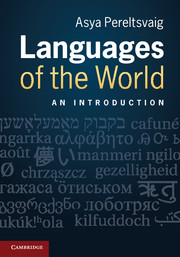Book contents
- Frontmatter
- Contents
- Figures
- Maps
- Tables
- Words, words, words…
- Acknowledgements
- Abbreviations used in the glosses
- 1 Introduction
- 2 Indo-European languages
- 3 Non-Indo-European languages of Europe and India
- 4 Languages of the Caucasus
- 5 Languages of Northern Africa, Middle East and Central Asia
- 6 Languages of sub-Saharan Africa
- 7 Languages of eastern Asia
- 8 Languages of the South Sea Islands
- 9 Aboriginal languages of Australia and Papua New Guinea
- 10 Native languages of the Americas
- 11 Macro families
- 12 Pidgins, creoles and other mixed languages
- Glossary
- References
- Index of languages
- Index of terms
6 - Languages of sub-Saharan Africa
- Frontmatter
- Contents
- Figures
- Maps
- Tables
- Words, words, words…
- Acknowledgements
- Abbreviations used in the glosses
- 1 Introduction
- 2 Indo-European languages
- 3 Non-Indo-European languages of Europe and India
- 4 Languages of the Caucasus
- 5 Languages of Northern Africa, Middle East and Central Asia
- 6 Languages of sub-Saharan Africa
- 7 Languages of eastern Asia
- 8 Languages of the South Sea Islands
- 9 Aboriginal languages of Australia and Papua New Guinea
- 10 Native languages of the Americas
- 11 Macro families
- 12 Pidgins, creoles and other mixed languages
- Glossary
- References
- Index of languages
- Index of terms
Summary
According to most recent studies, sub-Saharan Africa is genetically the most diverse part of the world: the genetic diversity here is greater than in the rest of the world combined. This is not surprising given the Out-of-Africa theory, which postulates East Africa (researchers disagree as to the exact location) as the cradle of anatomically modern humans. It is highly probable that sub-Saharan Africa is also where human language first began to develop. Thus, it should come as no surprise to discover that Africa is possibly the most linguistically diverse continent on the planet.
So what languages are spoken in Africa? In Chapter 5, we discussed Semitic languages, which are considered as part of the Afro-Asiatic macro family (see Chapter 11); these languages occupy the northern part of the African continent. There are also some Indo-European languages (see Chapter 2) spoken in Africa; they have been brought to this continent by the European colonizers, with the exception of Afrikaans, which was born on the African soil as an offshoot of Dutch. One other language born on African soul and spoken in Africa – Malagasy – will be discussed in Chapter 8, where other Austronesian languages, to which it is related, are examined. In this chapter we will discuss several of the other languages found in Africa. Specifically, three language families are the subject of the following three sections. Two of these families are very large – the Niger-Congo family with 1,514 languages and the Nilo-Saharan family with 204 languages, and the third – the Khoisan family – comparatively small, with only about 30 languages.
- Type
- Chapter
- Information
- Languages of the WorldAn Introduction, pp. 105 - 123Publisher: Cambridge University PressPrint publication year: 2012



